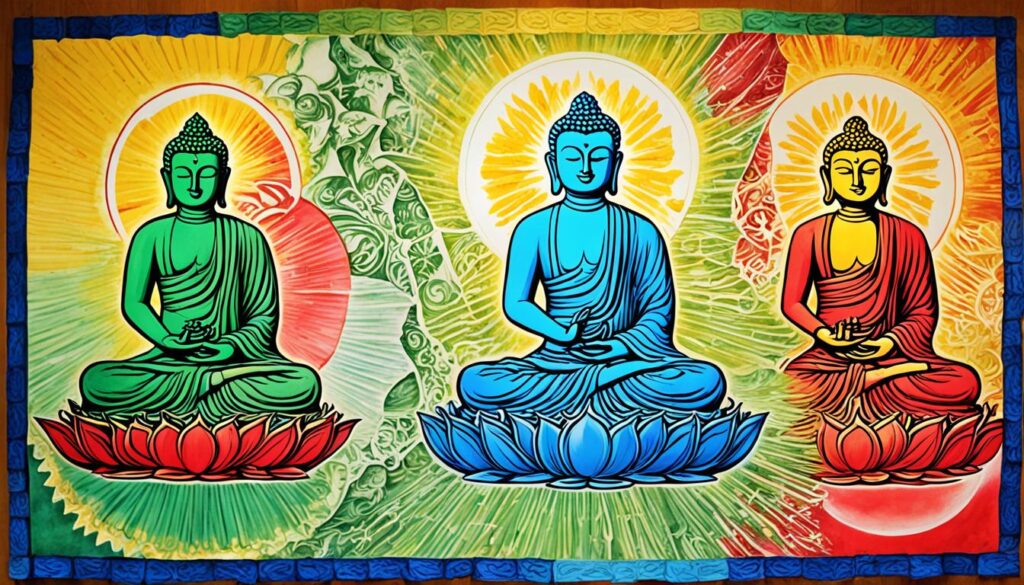“Thousands of candles can be lighted from a single candle, and the life of the candle will not be shortened. Happiness never decreases by being shared.” – Buddha
Welcome to the enlightening world of Buddhism! As one of the oldest and most influential religions in the world, Buddhism offers profound teachings and principles that have guided individuals towards inner peace and enlightenment for centuries. Central to the Buddhist faith are two major beliefs that lay the groundwork for understanding the nature of existence and the path to liberation.
Buddhist teachings, often referred to as Buddhist philosophy, encapsulate the core beliefs, principles, and tenets followed by millions of practitioners worldwide. The wisdom imparted by the Buddha encompasses not just religious doctrine but also practical approaches to living a fulfilling and compassionate life.
In this article, we will delve into the two major beliefs of Buddhism: the Four Noble Truths and the Noble Eightfold Path. Through exploring these foundational teachings, you will gain insights into the essence of Buddhism and discover how they pave the way for achieving personal and spiritual growth.
Key Takeaways:
- The Four Noble Truths form the cornerstone of Buddhist teachings, addressing the truth of suffering, its origin, cessation, and the path to its end.
- The Noble Eightfold Path provides a comprehensive guide for ethical conduct, mental discipline, and wisdom, leading individuals towards enlightenment.
- Karma and rebirth are fundamental concepts in Buddhism, emphasizing the consequences of one’s actions and the cyclic nature of existence.
- Meditation plays a vital role in Buddhism, serving as a practice to cultivate mindfulness and attain a state of enlightenment.
- Buddhism encompasses various schools and traditions, such as Mahayana, Theravada, Vajrayana, Pure Land, and Zen, each offering unique approaches to spiritual development.
The Four Noble Truths
The Four Noble Truths are the foundation of Buddhist teachings, providing profound insights into the nature of existence and the path to liberation from suffering. These truths, discovered by the Buddha, offer a roadmap for understanding the human condition and achieving enlightenment. Let’s explore each truth in detail:
1. The Truth of Suffering (Dukkha)
The first Noble Truth acknowledges that all human beings experience suffering in various forms. It encompasses physical pain, emotional distress, and the dissatisfaction that arises from the impermanence and unsatisfactoriness of life. Suffering is an inescapable part of the human condition, affecting everyone to some degree.
2. The Origin of Suffering (Samudāya)
The second Noble Truth reveals the root cause of suffering, which is desire or craving (tanhā). When we attach ourselves to worldly pleasures, possessions, and expectations, we create an endless cycle of wanting and clinging. This attachment inevitably leads to suffering, as our desires can never be fully satisfied.
3. The Cessation of Suffering (Nirodha)
The third Noble Truth offers hope by asserting that suffering can be ceased. It teaches that through the removal of desire and attachment, it is possible to attain liberation from suffering. By cultivating a mind free from craving and clinging, one can experience a state of inner peace, contentment, and ultimate liberation known as nirvana.
4. The Path to the Cessation of Suffering (Magga)
The fourth Noble Truth outlines the path to the cessation of suffering. Known as the Noble Eightfold Path, it provides a practical and comprehensive guide for leading a wholesome and enlightened life. The Eightfold Path consists of Right Understanding, Right Thought, Right Speech, Right Action, Right Livelihood, Right Effort, Right Mindfulness, and Right Concentration. This path encompasses ethical conduct, mental discipline, and the cultivation of wisdom.

The Noble Eightfold Path
The Noble Eightfold Path is the guiding framework for Buddhist practice and the way to achieve enlightenment. It consists of eight interconnected factors that encompass every aspect of an individual’s life. By following this path, individuals can cultivate wisdom, ethical conduct, and mental discipline, ultimately leading them towards liberation from suffering.
1. Right Understanding
Right Understanding involves gaining insight into the true nature of reality. It involves understanding the Four Noble Truths and the interconnectedness of all things.
2. Right Thought
Right Thought focuses on cultivating wholesome intentions and thoughts. It involves letting go of harmful or negative thoughts and nurturing thoughts of kindness, compassion, and non-attachment.
3. Right Speech
Right Speech emphasizes the importance of using words that are truthful, kind, and beneficial. It involves abstaining from lying, gossiping, harsh speech, and divisive speech.
4. Right Action
Right Action entails engaging in actions that are ethical and beneficial. It involves abstaining from harming other beings, stealing, and engaging in sexual misconduct.
5. Right Livelihood
Right Livelihood refers to earning a living in a way that is morally upright and contributes positively to society. It involves avoiding occupations that cause harm, such as dealing in weapons, trafficking drugs, or engaging in unethical business practices.
6. Right Effort
Right Effort requires the cultivation of positive qualities and the abandonment of negative qualities. It involves making a continuous effort to overcome unwholesome thoughts and behaviors and to develop wholesome qualities.
7. Right Mindfulness
Right Mindfulness involves being fully present and aware in the present moment. It entails developing mindfulness through meditation and applying it to every aspect of life, observing bodily sensations, thoughts, and emotions without judgment or attachment.
8. Right Concentration
Right Concentration refers to developing deep states of focused attention through meditation. It involves training the mind to achieve a state of calmness, tranquility, and single-pointed concentration.
By practicing and integrating these eight factors into their daily lives, individuals can walk the path of the Noble Eightfold Path and move closer to the ultimate goal of enlightenment.

Karma and Rebirth
Buddhism teaches that every action has consequences, and this principle is known as karma. You create your own destiny through your thoughts, words, and deeds. Karma is the moral law of cause and effect, where your actions in the past or present influence your future experiences. It is like sowing seeds; the kind of seeds you plant will determine the kind of fruits you reap.
According to Buddhist belief, karma extends beyond a single lifetime. Individuals go through a cycle of rebirth, being born into different realms based on their karma. This cycle continues until one attains enlightenment, also known as nirvana. Your actions in this life will determine the conditions of your next life.
The cycle of rebirth encompasses various realms, each with its own characteristics and experiences. There are three fortunate realms where beings enjoy greater happiness and well-being – the realm of demigods, gods, and humans. In these realms, individuals have the opportunity to practice and progress towards enlightenment.

On the other hand, there are three unfortunate realms where beings experience more suffering – the realm of animals, ghosts, and hell. In these realms, individuals may endure intense pain, torment, or feelings of restlessness. However, even in these realms, there is still the potential for transformation and growth.
| Fortunate Realms | Unfortunate Realms |
|---|---|
| Realm of Demigods | Realm of Animals |
| Realm of Gods | Realm of Ghosts |
| Realm of Men | Realm of Hell |
The realm of human existence is considered a precious opportunity for spiritual growth and liberation from suffering. It is said to provide the most favorable conditions for practicing the teachings of Buddhism and attaining enlightenment. The human realm is characterized by the ability to make conscious choices and cultivate wisdom.
By understanding the concept of karma and the cycle of rebirth, you become aware of the interconnectedness of your actions and their consequences. You have the power to shape your future through virtuous thoughts, compassionate words, and benevolent deeds. Embrace the opportunity of this human life to walk the path towards liberation and enlightenment.
Meditation and Enlightenment
Meditation is an essential practice in Buddhism that helps you cultivate mindfulness, concentration, and insight. By focusing your mind, you can attain a state of inner stillness and heightened awareness. Through the practice of meditation, you can embark on a transformative journey towards enlightenment and nirvana.

Meditation enables you to transcend the distractions of the external world and delve into the depths of your inner self. It provides an opportunity to explore your true nature and gain a profound understanding of the nature of reality. Through regular meditation practices infused with discipline and dedication, you can unlock the door to profound spiritual growth and self-realization.
Inner Stillness and Heightened Awareness
Meditation opens the door to inner stillness, creating a space where you can cultivate a deep sense of peace and tranquility. As you let go of external distractions and quiet the chatter of your mind, you create an environment in which profound insights can arise. This inner stillness also enhances your ability to observe your thoughts and emotions without judgment, fostering a state of self-awareness and self-acceptance.
Through regular meditation, you can develop a heightened awareness that extends beyond your individual self. This expanded awareness allows you to perceive the interconnectedness of all beings and the interdependence of everything in the world. By realizing your place within the greater tapestry of existence, you can cultivate compassion and empathy towards all living beings.
Practices and Techniques
There are various meditation practices and techniques within Buddhism, each serving a unique purpose and suited for different individuals. Some common forms of meditation include:
- Sitting Meditation: This is the most well-known form of meditation, where you sit in a comfortable position and focus your attention on your breath, a mantra, or a specific object.
- Walking Meditation: In walking meditation, you bring your mindfulness and awareness to every step you take, immersing yourself fully in the present moment.
- Chanting: Chanting mantras or sacred texts can help focus the mind and create a rhythmic flow that aids in concentration and spiritual connection.
It is important to note that meditation is a personal journey, and what works best for one person may not resonate with another. Exploring different meditation practices and techniques can help you find the methods that align with your individual needs and preferences.
Through consistent practice and a sincere commitment to self-exploration, meditation can become a powerful tool for personal growth, spiritual development, and the attainment of enlightenment.
| Meditation Benefits | Effects on the Mind | Effects on the Body |
|---|---|---|
| 1. Increased mindfulness | 1. Reduced stress and anxiety | 1. Lowered blood pressure |
| 2. Enhanced concentration | 2. Improved emotional well-being | 2. Boosted immune system |
| 3. Heightened self-awareness | 3. Enhanced cognitive function | 3. Improved sleep quality |
| 4. Increased compassion | 4. Increased resilience and equanimity | 4. Reduced chronic pain |
Different Schools of Buddhism
Buddhism has evolved into various schools or traditions over time, each with its own unique practices and teachings. The three main branches of Buddhism are Mahayana Buddhism, Theravada Buddhism, and Vajrayana Buddhism.
Mahayana Buddhism is prevalent in East Asia, including countries like China, Japan, and Korea. It emphasizes compassion and the enlightenment of all beings. Mahayana teachings encourage practitioners to strive for bodhisattva ideals, which involve selflessness and the pursuit of liberation for the benefit of others. This school of Buddhism places great importance on the concept of interconnectedness and the potential for all beings to attain enlightenment.
Theravada Buddhism, also known as the “Doctrine of the Elders,” is prominent in Southeast Asia, particularly in countries like Thailand, Myanmar, and Sri Lanka. It focuses on individual liberation through meditation, mindfulness, and monastic discipline. Theravada practitioners aim to achieve enlightenment and free themselves from the cycle of birth and death to attain liberation, also known as nirvana.
Vajrayana Buddhism, also referred to as Tibetan Buddhism, is practiced in Tibet and surrounding regions. It incorporates Tantra, a set of rituals and practices, to achieve enlightenment. Vajrayana teachings emphasize the use of meditation, visualizations, and mantras to quickly attain spiritual realization. This school of Buddhism is often associated with the Dalai Lama and the Potala Palace.
In addition to these main branches, there are other eastern schools of Buddhism that have emerged over time. These include Pure Land Buddhism, which places emphasis on the practice of devotion and the aspiration to be reborn in Amitabha Buddha’s Pure Land, and Zen Buddhism, which focuses on direct intuition and the experience of enlightenment through meditation and mindfulness.
| Branch | Key Characteristics | Main Regions |
|---|---|---|
| Mahayana Buddhism | Emphasis on compassion and the enlightenment of all beings | China, Japan, Korea, Vietnam |
| Theravada Buddhism | Focus on individual liberation through meditation and monastic discipline | Thailand, Myanmar, Sri Lanka, Cambodia |
| Vajrayana Buddhism (Tibetan Buddhism) | Incorporation of Tantric practices for achieving enlightenment | Tibet, Bhutan, Nepal |
| Pure Land Buddhism | Practice of devotion and aspiration to be reborn in Amitabha Buddha’s Pure Land | China, Japan, Korea |
| Zen Buddhism | Focus on direct intuition and experience of enlightenment through meditation | Japan, Vietnam, Korea |
Conclusion
Buddhism offers profound insights and teachings that guide individuals towards personal and societal harmony. The core beliefs of Buddhism, the Four Noble Truths and the Noble Eightfold Path, provide a roadmap for understanding and overcoming suffering.
By acknowledging the truth of suffering, its origin, and the path to its cessation, individuals can cultivate the wisdom necessary to navigate life’s challenges. The Noble Eightfold Path, encompassing moral conduct, mental discipline, and wisdom, offers a practical guide for living a mindful and compassionate life.
Meditation, a cornerstone of Buddhism, enables practitioners to develop mindfulness, concentration, and insight. Through this transformative practice, individuals can connect with their inner selves, attain inner stillness, and deepen their understanding of the nature of reality.
Buddhism’s inclusive philosophy has a lasting impact worldwide, inspiring millions of people to find peace and strive towards the ultimate goal of enlightenment. By embracing the teachings and practices of Buddhism, individuals can achieve personal liberation from suffering and contribute to the well-being of society as a whole.
FAQ
What are the two major beliefs of Buddhism?
The two major beliefs of Buddhism are the Four Noble Truths and the Noble Eightfold Path.
What are the Four Noble Truths?
The Four Noble Truths are the fundamental teachings of Buddhism. They include the truth of suffering, the origin of suffering, the cessation of suffering, and the path to the cessation of suffering.
What is the Noble Eightfold Path?
The Noble Eightfold Path is a guiding framework for Buddhist practice. It consists of eight interconnected factors, including Right Understanding, Right Thought, Right Speech, Right Action, Right Livelihood, Right Effort, Right Mindfulness, and Right Concentration.
What is karma and rebirth in Buddhism?
Karma refers to the moral law of cause and effect in Buddhism. It teaches that one’s actions in the past or present influence their future experiences. Rebirth is the concept that individuals go through a cycle of being born into different realms based on their karma.
How does meditation relate to enlightenment?
Meditation is an integral practice in Buddhism that helps individuals cultivate mindfulness, concentration, and insight. Through meditation, practitioners seek to attain enlightenment, which is a state of liberation from suffering and complete awareness of one’s existence.
What are the different schools of Buddhism?
Buddhism has different schools or traditions, including Mahayana Buddhism, Theravada Buddhism, Vajrayana Buddhism, Pure Land Buddhism, and Zen Buddhism. Each school has its own set of practices and teachings.
What is the importance of Buddhism?
Buddhism offers profound insights and teachings that guide individuals towards personal and societal harmony. By embracing the core principles of Buddhism, such as the Four Noble Truths and the Noble Eightfold Path, individuals can find peace and strive towards the ultimate goal of enlightenment.

